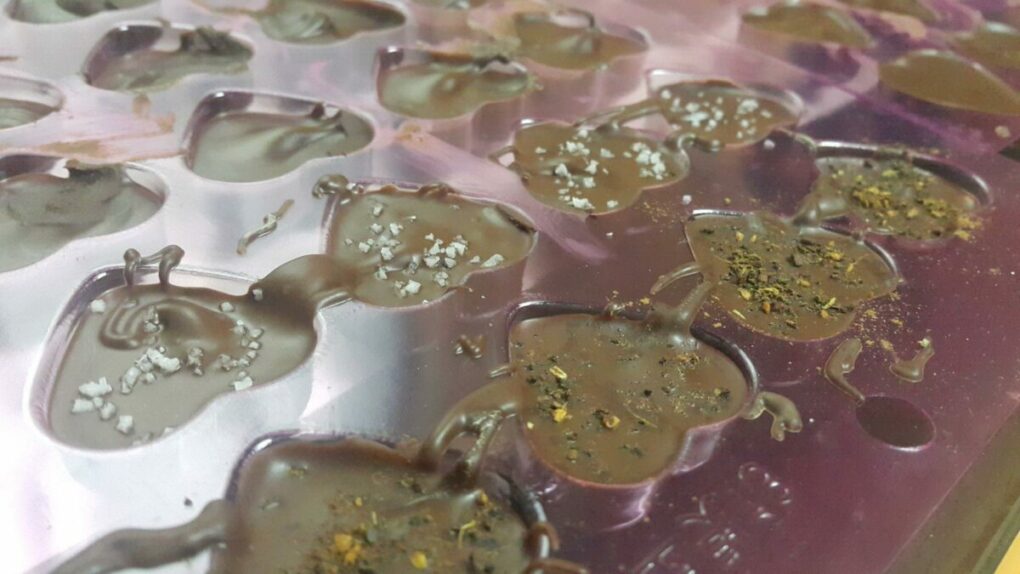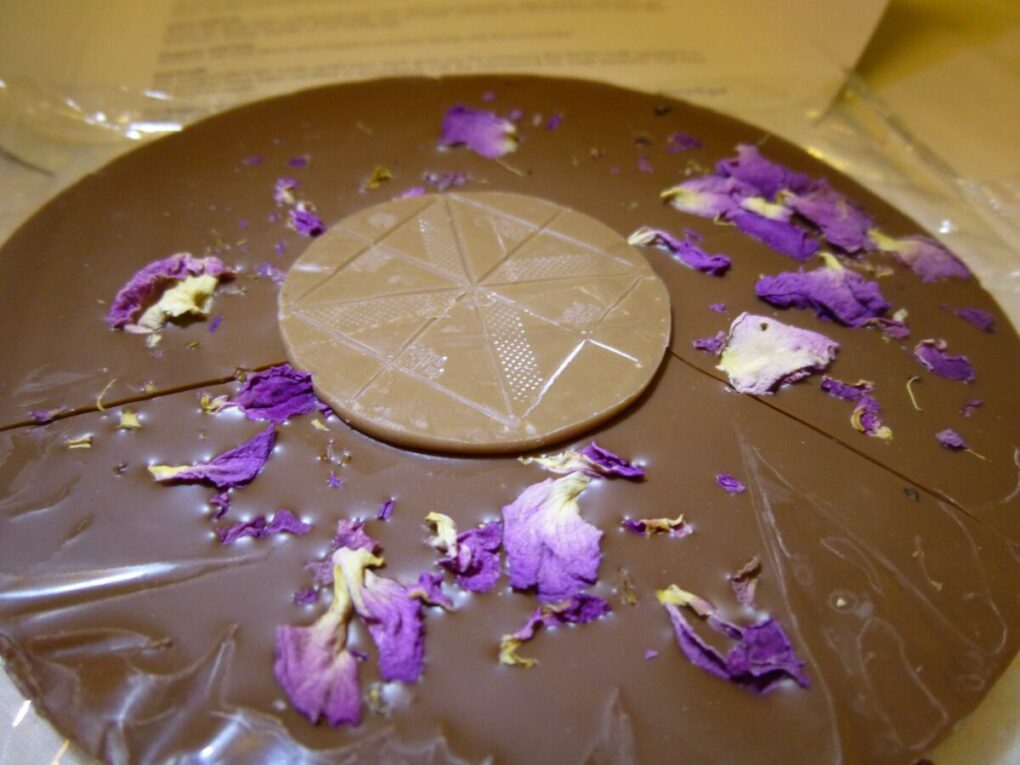Countless media portray chocolate as the gift of choice between lovers, friends, and family. Gifting chocolate is widely considered a symbol of love, but we never really discuss why. The notion is rooted in powerful marketing and chocolate’s history as a luxurious delicacy.
In the following sections, we tackle the history that might have led to chocolate becoming the go-to gift for love birds, as well as the ideas that associate chocolate with love & romance.

Jump To
Chocolate and Love in History
The core ingredient in chocolate is the cacao bean, which is thought to have originated from ancient tribes harvesting them from the fruit of the Theobroma cacao tree. Evidence shows that as far back as 5,300 years ago, cacao was domesticated in South America. Eventually, the cultivation of cacao trees found its way north to Central America, to the ancient civilizations of Mesoamerica: the Mayans, Toltecs, and Aztecs.
Written accounts by travelers suggest that cacao beans were valued more than gold, and used as a form of currency in these societies. In his excerpt, Jesuit theologian Jose De Acosta recounts that cacao beans were recognized to have value; they could be freely traded without haggling, and given to the poor when they asked for alms.
The fermented cacao beans were roasted, crushed, watered, and mixed with various flavorings and spices into a drink. Women were put in charge of preparing the beverages, which were was used in rituals and ceremonies. Royalty and the wealthy were said to have enjoyed it during engagements, marriages, and religious festivals.
The Spanish foot soldier Bernal Díaz del Castillo, in protest to historians, wrote the Historia verdadera de la conquista de la Nueva España (‘The True History of the Conquering of New Spain’). This ancient text is said to have popularized the notion that the Aztec Emperor Moctezuma used chocolate as an aphrodisiac, leading eventually to the modern-day connection between the two.

Why Do We Associate Chocolate with Love?
An early link between Valentine’s Day and romance comes from a poem, The Parlement of Foules, written sometime between 1380-90 by Geoffrey Chaucer. It’s thought to commemorate the Marriage of Richard II to Anne Bohemia in 1382, describing birds that meet to choose their mates on Valentine’s Day. Chocolate’s association with love is due in no small part to its rise in popularity as one of the gifts given on Valentine’s Day.
The trend of sending paper Valentines gained traction before chocolate, however. This was thanks to a compilation of pre-composed verses from The Young Man’s Valentine Writer, published in 1797, and compounded by the reduction of postal rates in 1840, with the release of the world’s first adhesive postage stamps, Penny Black. With the rise in popularity of paper Valentines, so rose the trend of exchanging gifts.
The global spread of cacao begins during the period of exploration by missionaries of the Spanish Inquisition. Records of the first shipment of cacao to Spain date back to the year 1585. While it was initially used as a medicinal elixir, too bitter for European tastes, the addition of milk, honey, cane sugar, cinnamon, and vanilla helped make the beverage palatable.
In 1606 the chocolate drink would be introduced into Italy and spread quickly throughout Europe. It became a high-status beverage, popular with the elite, and mixing in similarly expensive sweeteners & spices of the time made it a true luxury. Technological advances in the 19th century— like J.S. Fry and Sons’ chocolate bar in 1847, Daniel Peter’s milk chocolate in 1876, and Rudolf Lindt’s conche machine in 1879— expanded chocolate as candy and confection.
In 1868, Cadbury's, a British chocolate company, created decorative heart-shaped packaging for Valentine’s day. Thanks to this, page 90 of the 2017 Guinness Book of World Records, credits the first association between confection and romance to John Cadbury, eldest son of Richard Cadbury. The growing demand for chocolate products happened to coincide with the paper Valentine’s boom, and chocolate naturally became a part of the gifts being exchanged.
The Science of Chocolate and Love
Many believe chocolate to have medicinal properties; most Mesoamerican cultures documented its use as an elixir. The first bitter chocolate drinks that made their way to Europe were also consumed for medicinal purposes. While some of this is due to the energizing properties of sugar, many of these claims & effects can be attributed to the compounds found in cacao.
Cacao is rich in flavonoids, a potent antioxidant. Its theoretical use as an aphrodisiac comes from its natural stimulants, like caffeine and theobromine. They open blood vessels to improve the delivery of oxygen and nutrients to the brain, improving alertness. The increased heart rate and blood pressure that follow are also factors that have been thought to make female arousal easier.
Chocolate also contains phenylethylamine (PEA), which has been associated with romance due to its perceived positive effects on mood, and function as an antidepressant. The claims that chocolate is a helpful tool for love and romance may be thin, but don't let that stop you from considering it as a gift. If there’s any doubt, the cacao in chocolate has a long history of being valued highly and, although the prices may have dropped over time, is still in very high demand to this day.
The saying goes that love is irrational, and bombarding your loved one with facts will probably prove ineffective in melting their heart. The gesture of purchasing chocolate for your significant other is definitely romantic— and continues a powerful global trend that’s centuries old, and can truly help set the mood.

Chocolate and Love FAQ
Chocolate’s association with romance is primarily credited to Cadbury’s Valentine’s-themed packaging that started selling in 1868. The packaging aimed to capitalize on the celebration’s popularity to boost sales. St. Valentine’s link to romance can be traced back further, but chocolate and chocolate confection’s own growing popularity made it a fitting gift to exchange.
Among the three main types of chocolate, dark chocolate is the most highly associated with romance. Many of chocolate’s assumed health benefits are also linked to cacao, therefore dark chocolate with a high cacao percentage is the right pick.
No. However chocolate contains phenylethylamine (PEA), which is considered by some as the “love molecule” or “chemical of love” because people in love have been observed to have higher levels of PEA in their urine. However, chocolate contains small amounts of PEA, and an article points out that consuming chocolate does not contribute at all to PEA levels, as much of the compound is metabolized during digestion.
No. The myth that chocolate is an aphrodisiac comes from the fact that cacao contains stimulants & soothing phytochemicals such as caffeine, theobromine, anandamide, and phenylethylamine. However, most chocolate contains very little amounts, and you are more likely to exhaust yourself from digestion with the amount you’d be required to consume for it to have a significant effect.

















Comments
No Comments